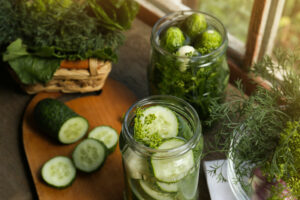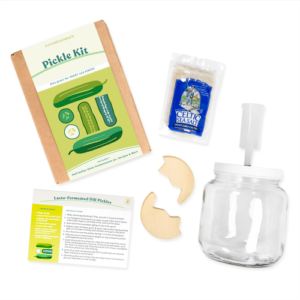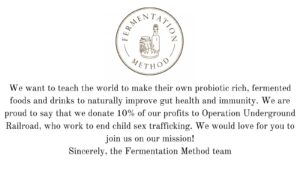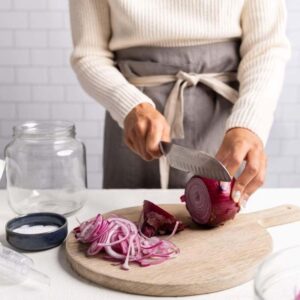Introduction
Learning how to ferment pickles is easy! Combine salt, water, and spices in a jar with cucumbers. Let the mixture sit for 3-4 days at room temperature. Then, move to the refrigerator. Enjoy delicious sour pickles in 2 weeks!

Pickling Techniques
Pickling is an ancient method of preserving food. In the past, pickles were often made with vinegar or lactic acid fermentation – but modern-day methods are simpler. Fermentation allows cucumbers to be preserved without adding additional preservatives or chemicals.
Check out Cultures for Health. Below is their pickle kit!
Fermentation is a traditional food preparation method that has been used for centuries. Learn how to ferment pickles so you can enjoy the health benefits of probiotics and create a crunchy and flavorful snack. This guide will teach you the basics of how to ferment pickles in your kitchen. It covers topics such as ingredients needed, tools required, preparation of cucumbers, creating the brine, fermentation process and storage instructions. With this guide, you’ll be fermenting pickles in no time!
Health Benefits of Fermented Foods
Fermented foods, including pickles, carry several health benefits that contribute to overall well-being. First and foremost, they are rich in probiotics, beneficial bacteria that promote gut health and enhance digestion. A healthy gut can improve immunity, mood, and even skin health. In addition, fermented foods aid in nutrient absorption due to the breakdown of food into more easily digestible components during the fermentation process. The high fiber content in these foods also supports weight management by increasing feelings of satiety. Lastly, fermentation can enhance the taste and texture of food, adding a tangy and savory flavor that elevates many dishes.
Ingredients
To begin your fermentation journey, start by gathering all of the ingredients and tools needed for the project. This includes fresh unwaxed pickling cucumbers, garlic cloves, dill sprigs, spices such as celery seed, mustard seed and coriander, salt meant for canning with no iodine or fillers, water that is filtered and unchlorinated and a large glass jar or fermentation crock.
Preparing the Jars
Begin by washing your jars, lids and rings in hot sudsy water and rinsing well. The rings and lids can be set to simmer (Not a roiling boil, just simmer) in a pan, The jars can be sterilized for 10-15 minutes in a water bath canner. Take out when ready to pack. Some people just put the jars in a 230F degree oven for 10-15 minutes.
A note of caution, don’t put cold food into very hot jars or hot food into very cold jars. I once poured boiling water into my jar without warming them. That resulted in a cracked ruined jar.
Preparing the Cucumbers
Once your ingredients are assembled, prepare the cucumbers by washing them thoroughly and cutting off both ends. Keep in ice water to keep crisp until ready to brine. Depending on how big you want the pickles to be, slice them into coins or spears. Then mix the brine that will be used to ferment the cucumbers.
All about Brines
The brine is a crucial element in the pickle fermentation process, as it creates the anaerobic environment needed for lactic acid bacteria to thrive. The recipe for creating a brine may vary, but it generally consists of water and salt, mixed in the right proportions. Here are a few examples of brine percentages commonly used in pickling:
- 2% Brine: This is a lighter brine, often used for fermenting delicate vegetables. To create a 2% brine, dissolve 20 grams(1 1/2 TBS) of salt in 1 liter(1 quart) of water.
- 3.5% Brine: This is a commonly used percentage for pickles and other vegetable ferments. To create a 3.5% brine, dissolve 35 grams(3 TBS) of salt in 1 liter(quart)of water.
- 5% Brine: This brine is often used for fermenting tougher vegetables or for longer fermentation periods. To create a 5% brine, dissolve 50 grams(4 TBS) of salt in 1 liter(1 quart)of water.
Remember, the key to successful fermentation is ensuring that your cucumbers are completely submerged in the brine. Then add any complimentary spices such as garlic, dill or other herbs for flavor.
Cucumbers need a 3.5 to 5% brine to safely ferment. If you plan to add onions to the jar they require 5% brine
Fermentation Vessel
The next step is to place the cucumber slices into the glass jar or fermentation crock, adding a few cloves of garlic and sprigs of dill before filling it with the brine. Make sure that all of the cucumbers are submerged and use a weight or other object to keep them below the surface of the brine if necessary.
Once everything is in place, secure a lid on a jar or crock and place it in a warm spot away from direct sunlight for fermentation. The temperature should remain between 65-75°F (18-24°C). Fermentation can take anywhere from a few days to several weeks, depending on the brine concentration and temperature.
For a deeper dive on fermenting check out the links below. This is an affiliates link.
Alternatively Cultures for Health has a whole site on fermenting! She has books, cultures and equipment. I love her site!
Done by Taste
You’ll know your cucumbers are done pickling when they have reached the desired level of sourness. When they’re ready, transfer them to an airtight container and store them in the refrigerator for up to 6 months
Other Vegetable to Ferment
You can also pickle other vegetables such as onions, cauliflower, and green beans. The same process applies: prepare a brine, add the vegetables into the jar or crock, seal it and let it ferment in warm temperatures. For firmer vegetables like green beans, you may need to use a higher percentage of brine (up to 5%) for longer fermentation times and crunchier results.
Spices and Vinegar
Once you have mastered the basic pickling process, try experimenting with different spices and herbs to create unique flavor combinations. You can also add fresh fruit like lemon or lime for a zesty twist, or even use different types of vinegar such as balsamic or apple cider vinegar. By combining different ingredients, you can create pickles with a wide range of flavors. Just don’t change the percentage of salt to water in the brine. That’s what allows for safe fermentation.
Pickled vegetables can be served as part of salads, or sandwiches, or enjoyed on their own as an appetizer. Have fun experimenting and customizing your recipes to create the perfect pickle!
Conclusion
Pickling is an easy and fun way to preserve vegetables for months. Not only is it a great way to reduce food waste, but it also allows you to create unique flavors that can be enjoyed in many different ways. Although the basic process stays the same, don’t forget to experiment with spices and vinegar for added flavor. With some practice, you’ll be able to create delicious pickles in no time! Enjoy!
Note: This content is for informational purposes only and should not be considered medical advice. As always, consult with your healthcare provider before making any changes to your diet or medications including herbs.
If you want to know how to home can pickles for shelf-stability check here.
If you want to know more about the many benefits of fermented foods check here.
Resources:
https://extension.umn.edu/preserving-and-preparing/how-make-fermented-pickles



